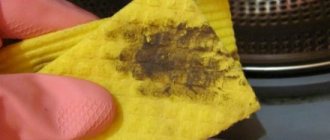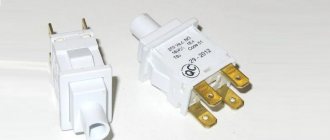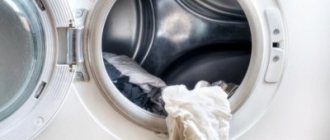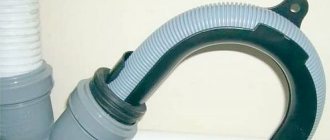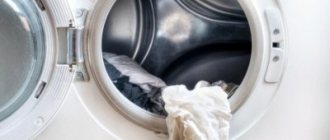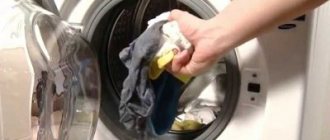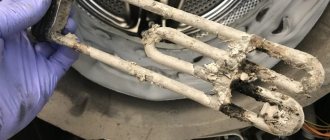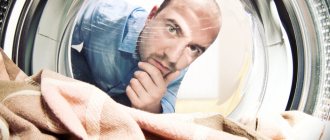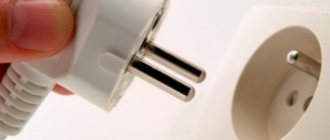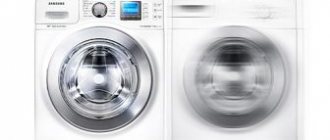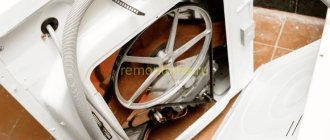The washing process seems to be proceeding, but the spin mode does not work. What to do: call a specialist, take the washing machine to a service center or buy a new one? It can be especially unpleasant if the cause of a “global” breakdown is clogged and worn brushes, which can be repaired yourself. If the washing machine does not spin out water, then you need to find out the reasons for the breakdown and further repairs, first check the operation of the program, and see if the spin function is disabled. It is necessary to exclude failure of several system components and other problems:
Drain malfunction
If the spin in the machine does not work for this reason, then you need to remove the hose from the sewer drain and place it at a lower level. Ideally - right on the floor. In fact, it will be enough to lower most of the hose (tube) lower than the washing machine tank so that the water begins to actively drain. The problem occurs in 2 cases:
- if the design has a bend in a flexible drain tube that works like a siphon;
- if the short drain tube or hose is dirty.
Picture 1
Draining water from a hose
The machine should drain the water. If this is not the case, then the spin mode does not work due to a malfunction of the hose and other elements:
- Filter. If the washing machine does not spin clothes and there is no drain, then there is a possibility of a blockage. In this case, water must be removed through the holes located before the drain pipe. All modern models have a filter that protects the drain pump from objects: paper clips, lumps of thread, small coins. Usually the filter is located on the front of the washing machine at the bottom. You can get to it through a round hatch by detaching the decorative panel that hides the base of the case.
Figure 2
You need to tilt the washing machine on its side, unscrew the filter and place it in a horizontal plane again. A water container is installed under the drain filter hole. This method is easy and effective. Removes water almost completely. There is a negative point - some of the water may spill on the floor.
- Emergency drain hose. Most washing machine models are equipped with a special flexible tube for emergency drainage, which is connected directly to the tank, bypassing the drain pipe and filter element. Some models have an emergency hose attached to the drain system after the filter. It may not turn on if the filter or pipe is dirty. In practice, removing water through the emergency tube takes a long time due to its small diameter. Typically, the emergency hose is located next to the filter (if there is a hatch) or on the other side under the removable panel. To drain the water using it, you will need to pull out the plug and direct the hose into the vessel.
Figure 3
Draining water through an emergency hose
How to prevent spin problems
A large percentage of household appliance breakdowns is associated with non-compliance with safety measures, operating rules and careful and attentive care of washing machines. In order to avoid critical situations when expensive repairs or complete replacement of parts are required, you should follow a certain number of rules and recommendations that will extend the life and functionality of the washing machine.
- To prevent fluctuations in electrical voltage from becoming a threat to the washing machine, it is worth installing a voltage regulation surge protector.
- Don't overdo it with laundry detergent: more is not always better. Follow the prescribed norm.
- Never overload the machine with laundry - there should be moderation in everything!
- After washing, remove the dispenser and clean it of any remaining washing powder and washing gels.
- The nest in which the dispenser is located should also be cleaned with a cloth until it becomes dry.
- The rubber cuffs on the washing machine doors also require care: after washing, dirt, threads, powder particles and products that destroy the structure of the part settle on them.
- After washing, leave the hatch door open for 20-30 minutes to dry the inside of the drum and internal parts.
- Do not use concentrated detergents for cleaning: they may corrode some rubber and plastic parts.
- After washing, ventilate the room and do wet cleaning. Make sure that the parts are intact and that there are no leaks from under the lower housing of the unit.
Now you know how to properly care for your washing machine before and after washing. By following these simple points, you will not only extend the life of your equipment, but also save your budget. Also remember that if the spinning system stops working properly due to reasons related to the electronic module, motor and interruptions in programs, this is the reason for immediate contact with a specialist.
Wrong program selected
Usually the spin mode in the washing machine does not work due to incorrectly configured software. There may be a problem with the washing program that was installed: the water does not pour out after the wash is completed, and the machine waits for the required command to drain the liquid and spin the clothes.
Figure 4
When the spin cancel button is pressed, it is depicted in the form of a spiral - crossed out with a line diagonally. If this button is pressed, the wash will not spin. Disable it to allow the process to resume.
The speed control is set to 0 - this is the reason why the washing machine does not spin the clothes, but drains the water.
Exceeding the range of motion inside the tank
Modern models of washing machines are programmed to detect the amplitude of vibrations of the laundry inside the tank during spinning. If the level of fluctuations exceeds the permissible norm, the device simply stops spinning the laundry. There may be several reasons for exceeding the amplitude of oscillations.
Incorrect installation of the washing machine
This often happens when the machine is installed on an uneven floor or an obstacle gets under the leg. To solve the problem, you need to adjust the legs of the device, preferably using a level. Use special pads or rubber mats to keep the machine stable.
Failure of shock absorbers
The task of shock absorbers in a washing machine is to dampen vibrations in the tank. The reason for premature wear of shock absorbers can be washing large masses of laundry, which during the spin cycle are constantly lumped together, creating an imbalance. As a result, the machine begins to jump, and the spin quality decreases significantly. If the shock absorbers do not work at all, then in this case the spin mode may not turn on. Replacing the shock absorbers will help solve the problem. In this case, it is best to seek professional help.
The pump is faulty or clogged
Figure 5
The most common problem is a clogged pump. When you remove the filter of the device, you can see the cross-shaped pump blades inside. You need to scroll them with your finger. If they don't spin, then something is stuck. Therefore, you should inspect the pump and remove the blockage inside.
If spinning occurs, but the water does not go down the drain, then the clothes remain wet after twisting. To repair, you need to change the pump. How to replace the pump in different models of washing machines:
- Turn off equipment from power sources, water supply, drainage.
- Mount the housing in a side position.
- Detach the bottom to gain access to the pump.
- Unscrew the screws and disconnect the pump by pressing on the side of the drain valve.
- Disconnect the wires from the pump.
- Remove the clamps and pour some of the water into the prepared vessel.
After this, you need to disassemble the pump, remove and clean the volute (if it is suitable for use) and change the pump. At the end, collect all the elements.
How to clean the drain filter
I would like to say a few words about this, because your actions will depend on the specific model of the washing machine:
- In Indesit, the hatch is made of fragile plastic material, and it must be opened quite carefully;
- Samsung is distinguished by the presence of special latches that open with a simple screwdriver;
- The hatch in Lg will not give in to you easily - you must press the button intended for this;
- Ardo also has access to the filter element from the front, but from the front side of the housing.
Unscrewing each filter is done the same way, only on certain models there are screws in the form of clamps. It is recommended that you carefully inspect the cap before you try to unscrew it.
Having organized access to the filtering device, it must be thoroughly cleaned and installed in its place. After this, it is recommended to test the washer. It is quite possible that this was not the only problem.
Laundry is not distributed correctly
A common reason why a washing machine does not spin. Modern machines recognize that objects are unevenly placed inside the drum and do not turn on the spin program until they have resolved the problem, or they stop the wash and indicate an error code on the screen.
To avoid this situation, you need to cancel the spin cycle when washing clothes, especially duvet covers. At the end of washing, rinsing and stopping, you need to take out the laundry and straighten it, and then throw it back into the drum and set the spin program.
Some machine models have a built-in function for analyzing the condition of the laundry: if the device has detected that the items do not meet the requirements, then you need to check the “No spin” button. It is possible that the no-twist function was enabled accidentally.
Correct operation
If you are faced with the problem that the washing machine has stopped spinning things, then you have neglected the operating recommendations.
As you know, a washing machine wrings things out only after washing, but the correctness of the latter is not so difficult to maintain.
To keep your machine always in shape, you need to adhere to the following:
- Empty your pockets of foreign iron objects.
- Use special bags for washing underwear.
- Sort clothes by size.
- Consider the dimensions and maximum capacity of the unit.
- Connect the machine to special surge protective devices.
Technical generator breakdown
A rare reason why the spin cycle does not work. Device malfunction occurs when the drum is frequently overloaded. If the loading rate specified by the manufacturer is regularly violated, this element may stop working in a short time. The tachogenerator is mounted on the shaft of the power unit and is designed to control speed during the washing process. If the sensor breaks, then the washing machine does not spin out the laundry; the rotation speed is not enough to perform this action.
Another reason for the malfunction of the tachogenerator is loosening of the contacts and wires leading to this element. To diagnose the problem, you need to check the fasteners and tighten them tighter.
Figure 6
If the wiring or adjacent contacts are damaged, they must be cleaned and taped. If the tachogenerator itself malfunctions, the part must be repaired or replaced.
Broken lock on the hatch
Sometimes the washing machine may start the washing process, but after a while it stops. The cause of the malfunction may be a failure of the hatch locking device. Repairing it yourself is labor-intensive and requires special skills and knowledge. To fix the problem, it is best to replace the UBL (hatch blocking device) with a new one.
Engine repair
The washing machine does not spin clothes due to a breakdown of the power unit? If the machine is equipped with a conventional belt motor rather than an inverter motor, the brushes will gradually wear out, causing a problem. If the motor is not running properly, the drum cannot reach the speed required for the final washing phase.
You can solve the problem yourself if you have mechanical knowledge: you need to remove the back wall of the case, then the strap from the electric motor and disconnect the wires, and then unscrew the electric motor itself from the drum. During diagnostics, faulty engine parts can be identified and replaced with new ones.
How to determine a power unit failure:
- if the engine sparks during the test, then the brushes need to be replaced;
- in case of strong noise and overheating of the equipment, the cause may be a violation of the integrity of the winding;
- peeling of the lamellas and the appearance of burrs on them entails the occurrence of sparks.
The lamellas should be checked during disassembly at the same time as the graphite brushes.
Figure 7. Engine.
Damages need to be eliminated as follows:
- Turn off the machine - disconnect drains, water pipes and electronic networks.
- Disassemble the product body: remove the panel and straps.
- Unscrew the bolts securing the engine.
- Disconnect terminals and wires connected to other elements.
- If the tank prevents access to the engine, you need to lift it.
- Different models have an individual device, so you need to remove the walls on the sides of the unit to properly remove the motor.
After this, you need to lift the broken elements or tighten their fastenings for normal operation.
Conclusion
In some cases, you can perform diagnostics and repairs yourself. Often this procedure requires special knowledge and additional equipment. If the necessary repairs are clearly beyond the capabilities of the average user, then you need to invite a professional.
After the drain function is restored, the machine will be able to proceed to spinning the laundry after the wash is completed. The information provided in our article is relevant not only for equipment from Samsung, but also for models from other manufacturers.
Faulty motor brushes
Signs of breakdown: the machine sparks and does not gain speed during the spin cycle, and the parts themselves are worn out and come into weak contact with the collector. Because of this, the power unit does not create enough torque to rotate the drum during the spin cycle.
The washing machine does not spin: what to do or how to replace and change the brushes:
- Disconnect from the network.
- Close the water inlet valve.
- Drain some of the water from the tank by unscrewing the inlet pipe. Attention! Water may suddenly start flowing.
- Remove the lower front part by removing the drain filter and draining some of the water using an emergency hose.
- Position the machine so that it is convenient to work with it.
- After this, you need to remove the engine by removing the back cover - it is secured with screws.
- Remove the drive belt. To do this, pull it slightly towards you and turn the pulley counterclockwise.
- Take a photo of the location and connection of the wires and disconnect them.
- Inspect the motor without dismantling.
After that, proceed to replacement:
- Unscrew the brush holder bolts and remove;
- carefully select the carbon rods;
- remove the brush from the socket;
- install a new product;
- repeat the procedure for another carbon contact.
Figure 8.
Motor brushes
If the unit is equipped with a direct drive, then the sequence of actions is different:
- Remove the rear cover.
- Remove the rotor. This is required to access the brush holders.
- Replacement brush is similar. You need to watch the direction of sharpening.
Before installing new parts, you need to wipe the collector with a cotton swab to clean it of carbon deposits and dust.
How to avoid serious equipment breakdown
It is advisable not to wait for vital household appliances to break down. It is no secret that sudden surges in voltage in electrical networks can damage electrical appliances. To avoid this trouble, use special surge protectors for your home needs. They will protect sensitive devices from voltage surges, for example, during an unscheduled power outage.
Always check pockets, buttons, and small items before loading clothes into the drum. Modern washing machines can easily be damaged by a coin falling out during washing or a button with sharp edges coming off. They get stuck in working elements, tear rubber gaskets or fly into drain holes. All this is then difficult to detect and correct. Therefore, prevention is very important.
You should put exactly as much powder or gel in the cleaning agent compartment as required according to the instructions. Some people stubbornly use a double dose of washing powder, hoping for a more effective wash. In fact, this is not always justified. If there is a large accumulation of product, the water sensor may be damaged or the feed tray may become clogged. This can lead to poor spinning of things. As for special advertised remedies for scale and sediment, many craftsmen consider this a kind of homeopathy among machine care products.
No matter how much you want to urgently wash all your things, do not overload the drum. Even if you managed to fit two sets of bed linen, two winter jackets and socks, this does not mean that the drum will be able to spin all this for two hours, and even wring it out. Laundry loading standards were invented for a reason. Observe them so that the drum does not fail.
Checking the control module
This component is responsible for all machine system programs, in particular spin execution.
Figure 9.
Control module
The spin function cannot be started due to a module malfunction. You won’t be able to check the control unit at home, so you will need the help of a specialist.
If the control unit malfunctions, the technician diagnoses the board, replaces the broken parts with new ones, and then solders the tracks and contacts.
Problems with the control unit
It should be noted that problems with spinning very rarely arise due to problems in the control unit.
Typically, a malfunction of the control board manifests itself not only in the impossibility of spinning, but also in other stages of washing. If problems occur with the control board:
- washing programs can jump from one another;
- the machine freezes;
- the selected washing program cannot be completed, but after restarting the machine everything returns to normal;
- The sensors on the control panel flash randomly.
If you do not observe such oddities, then you probably shouldn’t go to the control board, but rather check other parts of the machine. If, during a quick external inspection of the control unit, you notice traces of soot, burnt wires, etc., then it is better to seek help from a specialist who knows how to figure everything out.
After all, the control unit is a very expensive and complex element of the washing machine. On average, its cost is 30% of the cost of the car, so repairing it yourself, especially in the absence of the necessary knowledge, is absolutely not worth it.
Damage to shock absorbers and bearings
These products are used to dampen vibrations in the washing machine during washing and spinning. When they wear out, the device vibrates strongly, and the electronics do not spin the drum, and the spin mode in the washing machine does not work. It is also possible for the drum to knock on the body part.
If the bearings break, the seal gradually loses its tightness, liquid gets inside the products and washes out the lubricant. The bearings begin to rust and are destroyed by vibration. When the drum is shaken by hand, it dangles on the shaft. There may also be leaks on the outside of the tank. Bearings need to be replaced.
The washing machine does not want to spin - probable malfunctions
The list of breakdowns associated with spin failure is quite large. It includes both drive malfunctions and breakdowns of sensors, heating, control module and structural parts.
The motor brushes are worn out - from RUB 1,300*
The carbon brushes in brushed motors are responsible for transmitting voltage to the rotor so that it can rotate and the motor can run. Over time, parts wear out and contact becomes weaker. The engine starts running intermittently and picks up speed poorly. Perhaps the washer sparks at the bottom due to poor contact of the brushes with the commutator.
Worn brushes during washing and rinsing can be identified by slow rotation or jerking of the drum, as well as increased program time. During the spin cycle, the engine cannot gain speed, and the SMA turns off.
The brushes cannot be repaired; they need to be replaced with new ones.
Bearings are worn out - from RUB 3,000*
The drum on the shaft rotates easily thanks to bearings. Although the parts are protected by an oil seal, over time it leaks. The ingress of water gradually washes away the lubricant, and the bearings rust and collapse.
Because of this, the drum dangles on the shaft, rotates poorly and makes a lot of noise during the spin cycle when trying to gain speed. The washing machine does not spin clothes, although it seems to wash and rinse normally. But until the bearing fell apart completely.
It is better not to allow such a breakdown to occur and replace the bearings earlier at the first sign of failure. Otherwise, repairs may be much more expensive due to damage to the tank.
Control unit - from 1800 rubles*
The control module (electronic controller) is responsible for the operation and interaction of all SMA nodes. Due to voltage surges or moisture ingress, the part of the microcircuit that is responsible for controlling the spin cycle fails in the module. Radio components and tracks burn. As a result, the washing machine does not always spin or there is no spin at all (the washing machine spins the drum slightly at low speeds and ends the program).
The technician will inspect and test the control unit. Then he will replace faulty radio elements, solder the tracks and contacts. If a significant part of the board is burned out or the processor fails, the control unit is completely replaced.
From the experience of the masters! In most cases, we repair control boards in the workshop; this is done by a separate technician who specializes in repairing electronic components. A service technician who visits clients removes the control module and takes it to an electronics technician. The board is repaired within two to three days; after the repair, the service technician delivers and installs the working module back.
Belt - from 800 rubles*
All washing machines without direct drive have a belt. It transmits rotation from the engine to the drum shaft. During operation, the belt stretches, becomes rough and cracks. Therefore, it begins to slip at high speeds and when accelerating the engine. During washing and rinsing, belt stretching has little effect on rotation. During the spin cycle, when the rotation speed increases, the engine cannot “accelerate” the drum due to belt slippage. Therefore, the drum either spins without picking up speed, or the spin stops. Also, a stretched belt can fly off the pulley. Then the rotation of the drum stops completely.
To fix the damage, you need to replace the belt.
Tacho sensor or Hall sensor - from 1800 rubles*
The tachometer is responsible for controlling the drum speed. It measures the voltage inside the magnetic coil included in its design and sends signals to the control unit, through which it commands the engine what to do, increase speed or slow down.
A faulty tachometer transmits incorrect data to the module, so the command to the engine to “start acceleration” is not received. The SMA does not spin due to insufficient rotation speed of the drum, which rotates constantly, but too slowly.
If the mounting screw is loose, the Hall sensor may also be faulty due to an incorrect position on the shaft. In this case, the technician will tighten the fasteners and fix the sensor.
If the device breaks down, it will have to be replaced with a new one.
Shock absorbers - from 2000 rubles*
The SMA tank suspension includes springs and shock absorbers. They are responsible for protecting the body and other components of the machine from vibration when the drum rotates. Shock absorbers keep the tank in a stable moving state, but do not allow it to move to the sides and vibrate strongly.
Dampers have an expiration date. After the resource is exhausted, they weaken and even break. When the shock absorbers wear out, the tank dangles and vibrates too much. That's why the machine knocks and jumps even while washing. The spin cycle on the washing machine does not work because the control unit does not give the command to reach the maximum rotation speed due to strong vibration.
Shock absorbers need to be changed to restore balance to the tank. Replacement is carried out in pairs at once, because the rigidity of the old working damper and the new one are different. Therefore, it is simply not possible to select a similar one to an existing working one.
Motor - from 1800 rubles*
The machine stops spinning even after the motor breaks down. The cause is usually a short circuit or break in the rotor or stator windings. In a commutator engine, the lamellas can also peel off.
When the windings are broken or shorted, the motor most often stops turning on. Although sometimes it can rotate very slowly, the spin does not work.
The lamellas peel off due to the heating of the housing. The cause of overheating is usually a winding break, if it was missed and the machine was “driven” with a slow-running engine.
The engine cannot be repaired. Rewinding windings, centering, replacing lamellas costs the same as installing a new motor. Therefore, it is easier to install a new engine with a guarantee than to try to revive the old one.
Pressostat - from 1500 rubles*
If the level sensor fails, the washing machine does not spin clothes, thinking that the tank is full, and waits for the water to drain. Although there is no water, the pressure switch is stuck in the “full tank” position.
The level sensor is not directly connected to the spin control, but incorrect data affects the operation of the control unit, which must signal the engine to “start rotating and reach high speed” in order for the laundry to be wrung out.
When repairing, the master:
- will check the chamber with the membrane that measures pressure, remove any blockage that may confuse the sensor;
- will look at the pressure switch tube and blow it out, if necessary; if there is mechanical damage, the hose will have to be replaced;
- will put the tube back on the fitting if it has fallen off;
- will completely replace the pressure switch in the event of a sensor failure (this happens quite rarely).
Broken pressure switch
Signs of a faulty water level switch, as this part is also called, are problems with diagnostics, lack of liquid when starting the wash, and exceeding the normal water level. The problem leads to the start of the heating element, a malfunction of the heating device. The result is poorly wrung out laundry and water in the tank.
The problem is solved by reconfiguring the level relay. A specialist who understands washing machines of a certain brand has the right to do the work. If the issue cannot be resolved this way, then the pressure switch needs to be replaced with a new one.
Video
From the following video you will learn how to restore the spin cycle if one of the above problems occurs.
She graduated from the Institute of Tourism of the Federal Pedagogical University with a degree in Management, loves to travel and communicate with people. She is interested in psychology, enjoys dancing, and studies English. During the five years of maternity leave, I thoroughly mastered housekeeping, not forgetting about my own development. He skillfully uses words and can support a conversation on any topic thanks to his interest in different areas of life.
Found a mistake? Select it and click the buttons:
The first officially patented washing machine was made of wood and was a box with a frame, half filled with wooden balls. Laundry for washing and detergent were loaded inside and the frame was moved using a lever, which, in turn, made the balls move and grind the laundry.
History knows the fact that a kitten fell into the drum of a washing machine and, after going through a full wash cycle on the “Wool” program, got out of the unit unharmed. The only trouble for the pet was an allergy to washing powder.
Washing machines have something to do with the origin of the expression “money laundering.” In the 1930s, American gangsters used a network of laundries as a cover for their illegal activities. By passing off the proceeds of crime as proceeds from cleaning clothes, they turned “dirty” money into “clean” money.
Astronauts, while in Earth orbit, solve the problem of dirty things using an original method. Clothes are dropped from the spacecraft and burn up in the upper atmosphere.
There are a variety of balls that are used in the washing machine. Antistatic ones will prevent the fabric from sticking to the body after washing, balls with special loops will “comb” the lint and prevent the appearance of pills, and silicone ones with pimples will prevent fluff from matting when washing outerwear.
Washing machines equipped with the “No Iron” or “Easy Iron” functions can wash clothes with little to no wrinkling. This effect is achieved through a special approach to spinning - it is performed at low speeds, with long pauses, and a small amount of water is retained in the tank.
There is a washing machine “for bachelors”. Linen washed in such a unit does not need to be ironed at all! The thing is that the device does not have a drum: some things can be placed inside the container directly on hangers (for example, jackets and shirts), and smaller things (for example, underwear and socks) can be placed on special shelves.
For washing small items on the road or in a hotel, it is convenient to use a regular plastic bag. Socks or tights are kneaded inside a tied bag along with water and a small amount of detergent. This method allows you to pre-soak things and wash them without damaging the fabric or wasting a lot of powder and water.
Failure of the heating element
The heater wires are located close to the body part. Electrical wiring frays due to strong vibrations that are created during operation. The problem is solved by soldering the damaged sections or replacing the wires.
Figure 10.
If the heating element does not function due to scale, then you need to use a softener. This element may not work if the heating sensors and liquid level detection are faulty. In this case, instead of the heating element, you only need to replace the broken elements.
Why did the problem occur?
In automatic washing machines, after starting the wash, many processes occur. First, water is drawn into the tank and the powder is washed away from the prewash cell. Next, the drum of the machine begins to spin slowly. This is how the pre-wash is carried out.
Then the dirty water is drained and clean water is collected again. This water flushes the detergent from the main wash compartment. When the main wash process is completed, the waste water is drained again and clean water is collected. The laundry rinsing process starts.
Today, automatic washing machines can perform a double rinse when selecting certain wash options. In other words, the machine draws water from the water supply twice to rinse the clothes.
After rinsing, the machine drains the waste contaminated water. Next, the spin cycle starts. And at this stage problems may arise.
The machine does not spin the drum, and after a short period of time it completely freezes. At best, the machine will display a system error. Then the owners will be able to find out about the malfunction. But sometimes the device does not produce any errors.
First you need to check the simplest reasons that have no connection with technical faults.
Such reasons are usually associated with the fact that the owner of the machine performed incorrect actions.
Such reasons include:
- the drum is overloaded with laundry;
- an item that is too bulky or heavy is loaded;
- The drum of the machine is not loaded enough;
- another washing program was selected (by mistake);
- a foreign object entering the tank jams the drum. As a result, the latter cannot accelerate to high speeds.
When the machine is overloaded, the laundry clumps into a lump and an imbalance in the drum occurs. During the spin cycle, the drum begins to rotate at high speeds and the laundry, knocked into a ball, can damage the drive mechanism. To prevent this malfunction, the machine stops the program immediately. To perform a spin cycle, you need to properly load the drum with laundry.
Insufficient loading of laundry into the machine drum can also cause the washing machine to freeze. The machine may freeze if you put something too bulky in it. The latest models of machines will immediately stop spinning if they recognize this.
The situation is much worse when a foreign object gets stuck in the tank. It may jam the drum or damage the tank. In the second case, water will flow out of the machine. Therefore, a stuck object must be pulled out immediately.
If it was not possible to find and eliminate the cause of the freeze at this stage, then you can move on to technical faults. Here, to find and fix the breakdown, you will most likely have to disassemble the machine.
You should not repair the device yourself if you are not sure that you can handle it. In this case, it is better to entrust the repair work to a specialist. Then save time and money.
Let's sum it up
The article provided instructions on what to do if the washing machine does not spin clothes. All actions are conditionally divided into categories:
- Removing liquid from the tank.
- Finding out the reasons for the breakdown.
- Trying to fix it yourself.
The last point is the most important. If you can reconfigure the program or remove the clogged drain tube yourself, in which case incorrect actions will not cause harm, then replacing damaged parts is the responsibility of a specialist. If you suspect that the cause of the breakdown is in the control module, then it is better to take the device to a service center yourself. Only a professional workshop has equipment to diagnose it.
Calling a master: how to find and how much to pay?
Sometimes you can even cope with a problem in the absence of a spin on your own, but it is better to entrust high-quality diagnostics and repair of components to a professional. To do this, you should contact a company that provides repair services for household appliances , and Samsung washing machines, in particular.
The cost of repairs consists of the prices for the work of the technician, the price of parts requiring replacement, and consumables. Depending on the complexity of the breakdown, the cost of repair increases. There may also be a difference in the price list of companies.
The average price for repairs in the capital (excluding the price of parts) is:
diagnostics of the pressure switch, repair, replacement – from 1,600 rubles;- replacement of shock absorbers - from 2,200 rubles;
- electric motor repair/replacement – from 2,000 rubles;
- replacement of bearings – from 3,300 rubles;
- replacement of tachometer – from 2,200 rubles;
- drain cleaning – from 1,100 rubles;
- replacement of motor brushes – from 1,400 rubles;
- replacement of the drive belt - from 900 rubles, etc.
The final cost is determined in each specific case.
You can find a Samsung washing machine repair company on the Internet. For devices that are still under warranty, you need to contact the service center with the problem . Information about them is indicated in the documents for the washing machine.
The technician is directly called by phone. The dispatcher needs to describe the breakdown of the washing machine and name the model (it is indicated in the passport for the device).
It is not advisable to turn to the services of a private craftsman, since the result can be poor quality work, installation of used parts rather than new ones, etc. In the worst case, you can even run into scammers who will scam you out of money and disappear.

